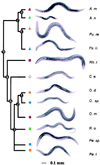Somatic polyploidization and cellular proliferation drive body size evolution in nematodes
- PMID: 10805788
- PMCID: PMC25820
- DOI: 10.1073/pnas.97.10.5285
Somatic polyploidization and cellular proliferation drive body size evolution in nematodes
Abstract
Most of the hypodermis of a rhabditid nematode such as Caenorhabditis elegans is a single syncytium. The size of this syncytium (as measured by body size) has evolved repeatedly in the rhabditid nematodes. Two cellular mechanisms are important in the evolution of body size: changes in the numbers of cells that fuse with the syncytium, and the extent of its acellular growth. Thus nematodes differ from mammals and other invertebrates in which body size evolution is caused by changes in cell number alone. The evolution of acellular syncytial growth in nematodes is also associated with changes in the ploidy of hypodermal nuclei. These nuclei are polyploid as a consequence of iterative rounds of endoreduplication, and this endocycle has evolved repeatedly. The association between acellular growth and endoreduplication is also seen in C. elegans mutations that interrupt transforming growth factor-beta signaling and that result in dwarfism and deficiencies in hypodermal ploidy. The transforming growth factor-beta pathway is a candidate for being involved in nematode body size evolution.
Figures





References
-
- Levi G. Ergeb Anat Entwicklungsgesch. 1925;26:86–352.
-
- Tessier G. Tabulae Biologicae. 1939;19:1–64.
-
- Conklin E G. J Morph. 1912;23:159–188.
-
- Wilson E B. The Cell in Development and Heredity. 3rd Ed. New York: Macmillan; 1925. pp. 97–99.
-
- Thompson D W. In: On Growth and Form; abridged edition. Bonner J T, editor. Cambridge, U.K.: Cambridge Univ. Press; 1969. pp. 39–40.
Publication types
MeSH terms
Substances
LinkOut - more resources
Full Text Sources

